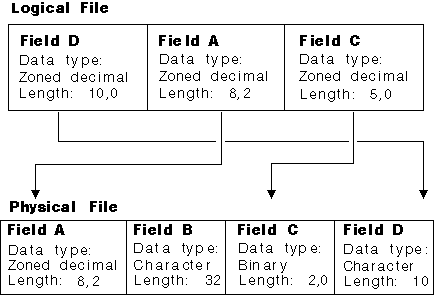For every logical file record format described with data description specifications (DDS), you must specify a record format name and either the PFILE keyword (for simple and multiple format logical files), or the JFILE keyword (for join logical files).
- The fields placed in a different order
- A subset of the fields from the physical file
- The data types changed for some fields
- The field lengths changed for some fields
You can use a logical file to make these changes.

For the logical file, the DDS would be as follows:
|...+....1....+....2....+....3....+....4....+....5....+....6....+....7....+....8
A
A R LOGREC PFILE(PF1)
A D 10S 0
A A
A C 5S 0
A
For the physical file, the DDS would be as follows:
|...+....1....+....2....+....3....+....4....+....5....+....6....+....7....+....8
A
A R PHYREC
A A 8S 2
A B 32
A C 2B 0
A D 10
A
When a record is read from the logical file, the fields from the physical file are changed to match the logical file description. If the program updates or adds a record, the fields are changed back. For an add or update operation using a logical file, the program must supply data that conforms with the format used by the logical file.
The following chart shows what types of data mapping are valid between physical and logical files.
| Physical file data type | Logical file data type | |||||||
|---|---|---|---|---|---|---|---|---|
| Character or hexadecimal | Zoned | Packed | Binary | Floating point | Date | Time | Timestamp | |
| Character or Hexadecimal | Valid | See Notes 1 | Not valid | Not valid | Not valid | Not valid | Not valid | Not valid |
| Zoned | See Notes 1 | Valid | Valid | See Notes 2 | Valid | Not valid | Not valid | Not Valid |
| Packed | Not valid | Valid | Valid | See Notes 2 | Valid | Not valid | Not valid | Not valid |
| Binary | Not valid | See Notes 2 | See Notes 2 | See Notes 3 | See Notes 2 | Not valid | Not valid | Not valid |
| Floating point | Not valid | Valid | Valid | See Notes 2 | Valid | Not valid | Not valid | Not valid |
| Date | Not valid | Valid | Not valid | Not valid | Not valid | Valid | Not valid | Not valid |
| Time | Not valid | Valid | Not valid | Not valid | Not valid | Not valid | Valid | Not valid |
| Time Stamp | Not valid | Not valid | Not valid | Not valid | Not valid | Valid | Valid | Valid |
Notes:
|
||||||||